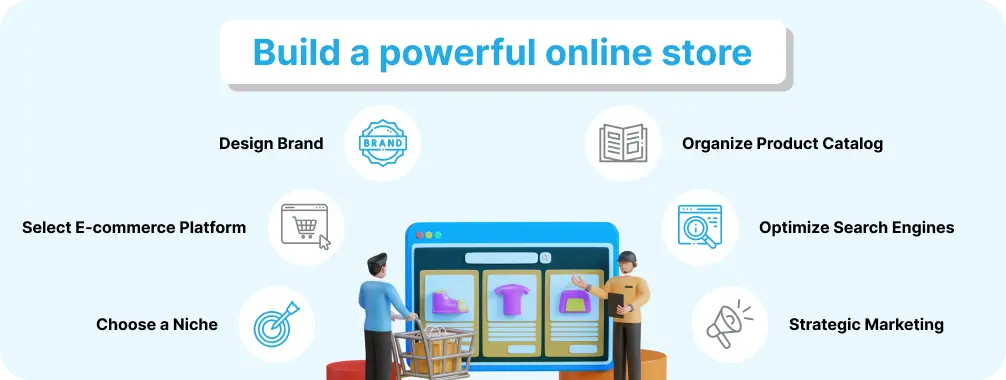

Are you ready to disrupt with AI? Join our Hackathon today! Click to Register
Table of Contents
ToggleIn the vast and competitive world of e-commerce, building a successful online store is not just a goal; it’s a necessity. As the digital marketplace continues to evolve, establishing a strong online presence can make all the difference in reaching and connecting with your target audience. In this comprehensive guide, we’ll walk you through the intricacies of creating a thriving online store, covering everything from choosing the right niche to ongoing optimization.
Now, imagine taking this complexity and injecting it with the efficiency and precision of automation. That’s the game-changer we’re delving into—a realm where custom software becomes your strategic ally in the pursuit of smart decision-making.
The foundation of a successful online store lies in understanding your market and catering to a specific audience. Begin with a SWOT analysis—identify your strengths, weaknesses, opportunities, and threats. This introspective approach will provide valuable insights into your business’s position in the market.
Next, scout for industry gaps. Dive into competitor research and pinpoint areas where your online store can stand out. It’s not about reinventing the wheel; it’s about making it spin differently.
Analyzing customer personas is crucial. Get to know the demographics, interests, and preferences of your target audience. This knowledge will not only help you tailor your product offerings but also shape your marketing strategies.
Choosing the right business model is the final piece of this puzzle. Whether it’s B2B, B2C, or D2C, align your business structure with your audience and product range.
With your niche and audience in mind, it’s time to choose the right e-commerce platform. Popular options like Shopify, BigCommerce, and WooCommerce offer distinct features to accommodate various business needs and budgets.
Consider factors such as ease of use, scalability, and available integrations when making your decision. Once chosen, set up your e-commerce website with a user-friendly design, intuitive navigation, and a seamless shopping cart experience.
Don’t forget to connect a secure payment gateway to ensure smooth transactions. Platforms often offer multiple options, so choose the one that aligns with your customer’s preferences and provides a secure payment environment.
In the crowded digital marketplace, your brand is your identity. Develop a strong brand presence with a memorable logo, a cohesive color scheme, and appealing product packaging. Your brand should not only reflect your products but also resonate with your target audience.
Branding isn’t just about aesthetics; it’s about telling a story. Craft a narrative that sets your online store apart. Create an emotional connection with your customers, and they’ll not only buy from you but become ambassadors for your brand.
A well-organized product catalog is the backbone of a successful online store. Group your products into logical categories, making navigation intuitive for visitors. Each product listing should include high-quality images, detailed descriptions, and options for multiple variants.
Invest time in crafting compelling product descriptions. Highlight the unique features and benefits of each item, and don’t underestimate the power of customer reviews. Positive feedback builds trust and credibility, turning potential customers into loyal patrons.
Now that your online store is set up, it’s time to ensure it’s visible to your target audience. Implementing SEO best practices is crucial for improving your website’s ranking on search engine results pages.
Start with keyword research to understand the terms your potential customers are searching for. Incorporate these keywords into your product listings, meta descriptions, and other relevant areas of your website. Regularly update your content to stay relevant in search engine algorithms.
Building a successful online store extends beyond the virtual walls of your website. Utilize a mix of marketing strategies, including social media, email marketing, content marketing, and paid advertising.
Social media platforms like Instagram, Facebook, and Pinterest can be powerful tools for reaching and engaging your audience. Craft compelling email campaigns to nurture relationships with your customers. Content marketing, through blogs or videos, establishes your expertise and builds trust.
Paid advertising, when strategically executed, can give your online store a significant boost. Experiment with different platforms and ad formats to find what works best for your business.

The journey to success doesn’t end with the launch of your online store. Regularly monitor website performance, analyze sales data, and pay attention to customer feedback.
Use analytics tools to track visitor behavior, identify popular products, and understand conversion rates. Customer feedback is a goldmine of information—listen to what your customers are saying and be open to making necessary adjustments.
Optimization is an ongoing process. Whether it’s tweaking your website design, refining your marketing strategies, or expanding your product catalog, staying adaptive is key to long-term success.

Want to elevate Your Business Online?
Reach Out and Start Your E-commerce Journey
with our experts Today!
Congratulations, you’ve navigated the intricate path of building a successful online store! From choosing your niche to ongoing optimization, each step plays a crucial role in establishing and maintaining a thriving e-commerce business.
Remember, the digital landscape is ever-evolving, and adaptation is your greatest ally. Keep refining your strategies, stay attuned to your customers’ needs, and embrace change as an opportunity for growth. Your online store isn’t just a business; it’s an evolving entity that has the potential to leave a lasting impact in the digital marketplace. Good luck!